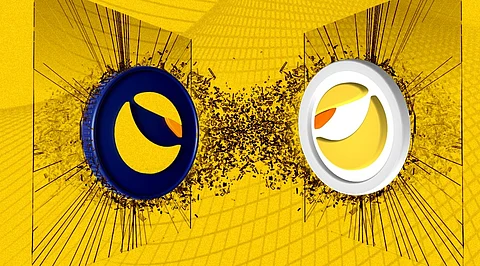

On 5 May, the crypto asset Terra — also known as Luna — was trading at US$80 a coin. On 7 May, UST, pegged against the US dollar, started falling on all crypto platforms across the globe. On 9 May, its value had fallen to 35 cents after a massive sell-off and on the other hand, Luna lost all its value and fell to almost zero. UST investors lost almost US$45 billion in just a matter of days. This sell-off in one coin triggered a broad sell-off in the crypto market globally and investors started pulling out their money from crypto assets and parking their money in safer ones, like gold. After this crash, the makers of Terra Chain came up with a revival plan but looks like this is also a big fail for makers as well as investors. So, which crash had cost more loss to the terra community? Let's find out.
Backers of Terra voted to revive the failed cryptocurrency Luna last week but with one big change. Luna is back without the element that caused the steep fall of the cryptocurrency two weeks ago – its stablecoin, UST.
After reaching a peak of US$19.53 on Saturday, luna dropped as low as US$4.39 just hours later, according to CoinGecko. It is now around the price of US$5.90.
"Terra 2.0 is coming," the company wrote on Twitter on Wednesday when it announced the news.
"With overwhelming support, the Terra ecosystem has voted to pass Proposal 1623, calling for the genesis of a new blockchain and the preservation of our community".
Stablecoins are cryptocurrencies that are usually pegged to a fiat currency, such as the dollar.
The most high-profile stablecoin is Tether, of which there is around US$75 billion in circulation. This makes it the third biggest cryptocurrency behind Bitcoin and Ethereum.
Tether is pegged to the dollar, meaning its value is supposed to remain stable at US$1.
This provides cryptocurrency investors with a way to exchange cryptocurrencies, such as Bitcoin and Ethereum, on exchanges, without converting the money to regulated fiat currency.
Investors can also exchange their more volatile cryptocurrencies for Tether to keep the dollar value at that time because the price is supposed to remain stable at US$1.
Terra (LUNA) is a public blockchain protocol that emerged from Terra Classic. Terra Classic is home to the algorithmic stablecoin TerraClassicUSD (UST). It's now-renamed LUNC token collateralized UST, which crashed in a bank run in May 2022. That devalued LUNA to virtually zero and caused a launch of a new chain — resulting in Terra Classic and Terra. Read a full breakdown of the Terra crash here.
The development of Terra Classic launched in January 2018 and the blockchain launched in April 2019. It attempted to combine the price stability and wide adoption of fiat currencies with the censorship-resistance of Bitcoin (BTC) and offer fast and affordable settlements through its UST stablecoin. Terra Classic offered stablecoins pegged to the US dollar, South Korean won, Mongolian tugrik, and the International Monetary Fund's Special Drawing Rights basket of currencies.
The new Terra blockchain continues the legacy of Terra Classic without the UST stablecoin. It will keep building with the help of the LUNA community dubbed "LUNAtics" and evolve the world-class UX and UI that brought Terra Classic up to second place in total value locked (TVL) at its peak. Many DApps have agreed to migrate to Terra to continue their functionality.
Whether it was one giant whale or collusion between large hedge funds, someone appears to have bought up around US$1 billion worth of UST stablecoins, while shorting their Bitcoin holdings.
Massive withdrawals were made from Anchor, decentralized finance (DeFi) protocol based on the Terra network. Deposits dove from US$14 billion to US$11.2 billion over just one weekend.
The existing negative market sentiment combined with fresh FUD — fear, uncertainty, and doubt) — led to the perfect conditions for a bunk run — people rushed to pull their money out.
Join our WhatsApp Channel to get the latest news, exclusives and videos on WhatsApp
_____________
Disclaimer: Analytics Insight does not provide financial advice or guidance. Also note that the cryptocurrencies mentioned/listed on the website could potentially be scams, i.e. designed to induce you to invest financial resources that may be lost forever and not be recoverable once investments are made. You are responsible for conducting your own research (DYOR) before making any investments. Read more here.
